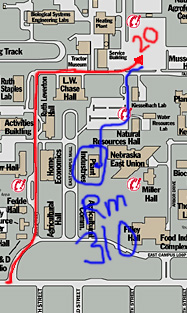
UNL/LHS Advanced Chemistry Research Project
Research question: Does the midgut tissue of Manduca Sexta rely on an endogenous source of C20:4 for prostaglandin biosynthesis or is an exogenous source required?
Introduction: Prostanglandin biosynthesis requires an organism to supply a ready source of Arachidonic acid (C20:4). The specific tissue contains low-level titers of C20:4 stored in the forms of phospholipids (PLs) and diacylglycerols (DGs). The mobilization of these fatty acids requires phospholipase activity. We are interested in seeing if the midgut of M.Sexta contains enough C20:4 within the tissue to metabolize prostaglandins as compared to in vitro metabolism.
1. Dissect & extract midgut from M.Sexta. Wash out midgut content, air dry & mass total tissue
2. Extract lipid samples: Sonicate, centrifuge & extract lipids with CHCl3 & CH3OH
3. Evaporate solvent. Mass total lipids.
4. Redissolve in CHCl3 and split into 2 samples (for total lipid analysis & for PL/DG analysis)
5. Evaporate down total lipid analysis sample and prepare for methylation.
6. Spot a TLC plate, along with lipid standards, for PL/DG analysis.
7. Run TLC plate in chamber. Pet ether: Ethyl Ether: Acetic Acid (80:20:1)
8. Scrap the PL/DG bands, extract lipids, & prepare for methylation
9. Add CH3OH & 100% H2SO4 (1mL:1drop). Reflux for 90 minutes
10. Extract methylated fatty acids and store in Pet Ether
11. Dry down and dissolve in Iso-octane
12. Run samples of Gas Chromatograph
13. Obtain integrated values for C20:4 and extrapolate total mass of C20:4 from percent composition.
Procedure to Prostaglandin Biosynthesis
1. Dissect & extract midgut from M. Sexta. Wash out midgut
2. Extract protein sample: Sonciate, centrifuge & extract protein
3. Assay for protein concentration
4. In vitro synthesis of Prostaglandin. C20:4 substrate, enzyme, & cofactor with boil control
5. Extract Prostaglandin in Pet Ether
6. Purify Prostaglandin with Silica Gel
7. Evaporate Solvent
8. Methylate with Diazomethane & add trimethyl silane using BSTFA
9. Run on GC/MS
Analysis
By comparing the amount of prostaglandin produced in vitro as a function of C20:4 substrate used, we can infer the basal level of prostaglandin produced from the quantified amount of C20:4 found in midgut tissue. This indirect assessment may identify if there exists enough C20:4 in midgut tissue for PG biosynthesis.
Itinerary
Friday, April 26th.
8:30 Arrive at UNL, Plant Industry. Orientation, Project Outline & Prep Insect for Dissection.
8:45 Introduction by Dr. Stanley. Insects as models for physiological & biochemical research.
9:00 Dissection, Protein Extraction/Analysis & Lipid Extraction
-Team 1: Prostaglandin Biosynthesis
-Team 2: Lipid Analysis
10:45 Prostaglandin Biosynthesis & Isolate Lipid Sample (TLC)
12:00 Lunch: Plant Industry Meeting Room.
12:20 Seminar: Physiology of Prostaglandins. Dr. Stanley
12:45 Extraction of Prostaglandin samples & Methylation of Lipids
Saturday, April 27th.
9:45 Recap experiment & overview of chromatography
10:00 Samples preparation for chromatography. Diazomethane & BSTFA reactions with PGs
10:30 Begin running standards on GC & GC/MS
12:45 Begin running samples on GC & GC/MS
12:00 Lunch. On our own.
12:30 Seminar: How insect immunity correlates mammalian immunity
1:00 Finish sample analysis and data processing
Map

Members:
Group 1. Team 1. Huong Le & Nghia Le
Group 1. Team 2. Kristin Williams & Jenny Truong
Group 2. Team 1. Angie Maske & Dimi Hua
Group 2. Team 2. Lien Phun & Tri Huynh